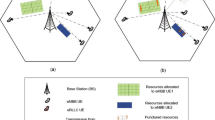Abstract
In current times, the intensity of Internet usage has been on a relentless rise, in pace with the release of numerous real-time applications like video transmission and non-real-time applications. Due to high error channels, the end-users will observe poor quality video over satellite network. The applications are competing themselves to inject their traffic into the network and hence end users get unfair shares of the bandwidth for the video transmissions. Also, the high transmission rate of video applications affects traditional Internet applications like e-mail. TCP-friendly rate control (TFRC), TFRC-satellite and multiple TFRC streams (MulTFRC), which are intended to provide congestion control, error control and increase bandwidth (BW) utilization respectively, may fail over the satellite networks with high error rate and high congestion. Besides, these connection-oriented protocols increase the applications overhead. In this paper, we present a cooperative flow regulation protocol (CFR), which provides fair access to both real-time and non-real-time applications, over networks with high congestion and high error. Verification of the proffered approach, by simulations, show that the CFR protocol reduces the loss of video frames by 30–40%, compared to DCCP and MulTFRC, and 50–60% compared to user datagram protocol (UDP) traffic, without compromise of the video quality.





Similar content being viewed by others
References
Damjanovic D, Welzl M (2009) Multfrc: providing weighted fairness for multimedia applications (and others too!). ACM SIGCOMM Comput Commun Rev 39(3):5–12
Floyd S, Kohler E (2006) Profile for datagram congestion control protocol (DCCP) congestion control ID 2: TCP-like congestion control. RFC 4341
Floyd S, Kohler E, Padhye J (2006) Profile for datagram congestion control protocol (DCCP) congestion control ID 3: TCP-friendly rate control (TFRC). RFC 4342
Floyd S, Handley M, Kohler E (2006) Problem statement for the datagram congestion control protocol (DCCP). RFC 4336
Floyd S, Handley M, Padhye J, Widmer J (2008) TCP friendly rate control (TFRC): protocol specification
Gineste M, Clarac L, Kuhn N (2018) Making H-ARQ Suitable for a mobile TCP receiver over LEO satellite constellations. In: Wireless and satellite systems: 9th international conference, WiSATS 2017, Oxford, UK, September 14–15, 2017, Proceedings, Springer, vol 231, p 33
Govindarajan J, Kousalya G (2016a) An efficient explicit error notification with adaptive packet size mechanism to improve TCP performance in LEO network. Appl Math Inf Sci 10(5):1915–1924
Govindarajan J, Kousalya G (2016b) A novel flow regulation protocol to optimize the end-to-end performance and fairness over LEO satellite network. Arab J Sci Eng 41(8):3239–3253
Gross J, Klaue J, Karl H, Wolisz A (2004) Cross-layer optimization of OFDM transmission systems for MPEG-4 video streaming. Comput Commun 27(11):1044–1055
Ha S, Rhee I, Xu L (2005) Cubic: a new TCP-friendly high-speed TCP variant. In: Proceedings of the third PFLDNet workshop
Hao G, Si P, Sun Y, Zhang Y (2019). TFRC-EA: an adaptive algorithm of TFRC in satellite networks. In: 2019 IEEE 11th international conference on communication software and networks (ICCSN), IEEE, pp 89–94
Katabi D, Handley M, Rohrs C (2002) Congestion control for high bandwidth-delay product networks. In: Proceedings of the 2002 conference on Applications, technologies, architectures, and protocols for computer communications, pp 89–102
Ke CH, Shieh CK, Hwang WS, Ziviani A (2008) An evaluation framework for more realistic simulations of MPEG video transmission. J Inf Sci Eng 24(2):425–440
Kohler E, Handley M, Floyd S, Padhye J (2006) Datagram congestion control protocol (DCCP). RFC 4340
Schier M, Welzl M (2012) Using DCCP: Issues and improvements. In: 2012 20th IEEE international conference on network protocols (ICNP), IEEE, pp 1–9
Sun Y, Ji Z, Wang H (2012) A modified variant of eXplicit control protocol in satellite networks. J Comput Inf Syst 8(10):4355–4362
Sun Y, Ji Z, Wang H (2013) TFRC-satellite: a TFRC variant with a loss differentiation algorithm for satellite networks. IEEE Trans Aerosp Electron Syst 49(2):716–725
Velenis D, Kalogeras D, Maglaris B (2002) SaTPEP: a TCP performance enhancing proxy for satellite links. In: International conference on research in networking, Springer, Berlin, Heidelberg, pp 1233–1238
Welzl M, Damjanovic D, Gjessing S (2010) MulTFRC: TFRC with weighted fairness. In: IETF Draft
Yu L, Li X, Zhang P, Li G, Ma M (2014) An improved transport algorithm over DCCP in wireless ad hoc networks. In: 2014 IEEE international conference on communication systems. IEEE, pp 569–573
Author information
Authors and Affiliations
Corresponding author
Additional information
Publisher's Note
Springer Nature remains neutral with regard to jurisdictional claims in published maps and institutional affiliations.
Rights and permissions
About this article
Cite this article
Govindarajan, J., Kousalya, G. Cooperative flow regulation protocol for real-time and non-real-time applications over satellite network. J Ambient Intell Human Comput 12, 979–990 (2021). https://doi.org/10.1007/s12652-020-02115-7
Received:
Accepted:
Published:
Issue Date:
DOI: https://doi.org/10.1007/s12652-020-02115-7




